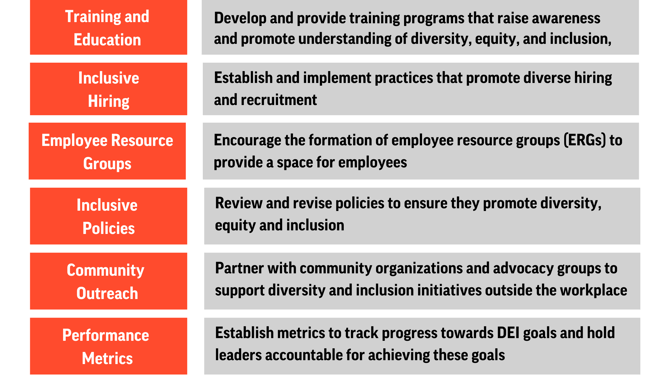Designing a Winning DEI Strategy: Best Practices
.png)
Diversity, Equity and Inclusion (DEI) are essential components of the modern workplace. In today's interconnected and multicultural world, companies are recognizing that a diverse and inclusive workforce is essential to success. Research has shown that diverse teams are more innovative, perform better and are more likely to make better decisions. An effective DEI strategy plan allows organizations to promote diversity, equity and inclusion in the workplace.
What is a DEI Strategy?
DEI stands for Diversity, Equity and Inclusion. A DEI strategy is a plan or approach that organizations adopt to promote and support diversity, equity and inclusion within the workplace. It involves creating an environment that values and respects differences, promoting a culture of inclusion, and providing equitable opportunities for all employees, regardless of their backgrounds, identities or abilities.
But why does diversity matter?
Diversity is not just an ethical obligation, but a business necessity. In a company it refers to the presence of individuals with different backgrounds, perspectives, and characteristics within the workforce. This can include differences in race, ethnicity, gender, sexual orientation, age, religion, education, socioeconomic status and more. Diversity encompasses the range of experiences and identities that people bring to the workplace, and it reflects the variety of ways in which people can contribute to the organization.
A diverse workforce can bring a wide range of skills, ideas, and perspectives to the organization, leading to greater innovation, creativity, and problem-solving ability. Diversity can also improve employee morale, engagement and retention, as employees feel valued and respected for who they are. In addition, a diverse workforce can help organizations better understand and serve their customers and clients, who themselves come from diverse backgrounds and communities, leading to improved customer satisfaction and increased revenue.
To fully realize the benefits of diversity, however, it is not enough to simply hire a diverse group of employees. Companies must also create an inclusive environment where everyone feels welcome, respected, supported and can thrive. This involves not only providing equal opportunities for all employees but also actively promoting diversity and inclusion in all aspects of the organization, from recruitment and hiring practices to leadership development and mentoring programs. Developing a DEI strategy is essential to creating a workplace where all employees feel valued and respected.
Inclusion is also critical for an effective and prosperous environment. Inclusive workplaces foster a sense of belonging and encourage employees to share their ideas and perspectives freely. An inclusive workplace can also help to attract and retain top talent, as employees are more likely to stay with an organization that values their contributions and provides a supportive work environment.
DEI also has significant social and ethical implications. Building a more diverse and inclusive workplace can help to reduce social inequalities and promote social justice. Organizations have a responsibility to create an equitable and inclusive workplace that reflects the diverse communities they serve.
Developing a DEI Strategy
Developing an effective DEI requires a systematic and deliberate approach, with clear and measurable goals, data-driven assessments and targeted initiatives to improve diversity, equity, and inclusion.
The first step is to establish clear and measurable DEI goals that align with the organization's values and mission. These goals should be specific, measurable, achievable, relevant and time-bound. For example, a DEI goal may be to increase the percentage of women in leadership positions by 20% within the next two years.
Next, it is important to gather data on the organization's current state of DEI. This includes collating data on employee demographics, retention rates, promotion rates, pay equity and employee engagement surveys. Analyzing this data can help to identify areas where the organization can improve its DEI efforts.
Conducting assessments of the organization's policies, practices and culture is also critical to developing an effective DEI strategy. This involves analyzing the organization's hiring practices, evaluating policies and procedures, reviewing training programs, and assessing the organization's overall culture and values. These assessments can help to identify areas of strength and opportunities for improvement.
Once areas of improvement have been identified, the organization can develop an action plan that outlines the steps it will take to achieve its DEI goals. This may include initiatives such as training and education, inclusive hiring practices, policy reviews and revisions, employee resource groups, community outreach, and performance metrics. For example, an organization may implement an unconscious bias training program to educate employees on how to recognize and address their unconscious biases.
Creating accountability measures is also essential to ensuring that the organization is making progress towards its DEI goals. This involves setting targets for diversity and inclusion, conducting regular surveys to measure employee satisfaction and establishing rewards and recognition programs for employees who demonstrate inclusive leadership behaviors.
Fostering an inclusive culture is also critical to an effective DEI strategy. This involves providing opportunities for diverse employee groups to connect, communicate and collaborate. It also means creating opportunities for all employees to participate in DEI efforts and ensuring that the organization's values and policies align with DEI goals. For example, an organization may establish an employee resource group for LGBTQ+ employees to provide support and advocacy.
Communicating and celebrating the organization's DEI strategy and progress is also critical and can be done by communicating the organization's plans and progress to employees, stakeholders and the broader community. Celebrating achievements and recognizing employees who demonstrate inclusive behaviors and attitudes reinforces the organization's commitment to DEI and creates momentum for future efforts.
Here are some DEI Strategy examples that organizations may implement:
- Training and Education: Develop and provide training programs that raise awareness and promote understanding of diversity, equity, and inclusion, as workshops, seminars, online courses, and other resources designed to educate employees on topics such as unconscious bias, microaggressions, cultural competence, and inclusive leadership.
- Inclusive Hiring: Establish and implement practices that promote diverse hiring and recruitment by establishing diverse hiring panels, expanding recruitment channels to reach a wider pool of candidates, and adopting equitable hiring practices that reduce the potential for bias or discrimination.
- Employee Resource Groups: Encourage the formation of employee resource groups (ERGs) to provide a space for employees from underrepresented backgrounds to connect, share experiences and advocate for their needs within the organization.
- Inclusive Policies: Review and revise policies to ensure they promote diversity, equity and inclusion. This can include establishing flexible work arrangements, accommodating employees with disabilities, providing equitable pay and benefits, and creating a culture that values and respects differences.
- Community Outreach: Partner with community organizations and advocacy groups to support diversity and inclusion initiatives outside of the workplace. Examples: sponsoring events, volunteering and supporting local initiatives that promote diversity and inclusion.
- Performance Metrics: Establish metrics to track progress towards DEI goals and hold leaders accountable for achieving these goals. This may include setting targets for diversity and inclusion, conducting regular surveys to measure employee satisfaction, and establishing rewards and recognition programs for employees who demonstrate inclusive leadership behaviors.

Challenges of Implementing a DEI Strategy
Implementing a DEI strategy requires the commitment and support of senior leaders, managers and employees at all levels. One of the biggest challenges of developing a DEI Strategy is overcoming resistance to change. This can come from employees who may feel threatened by the changes or from managers who are resistant to changing their hiring or management practices. It is important to address these concerns and provide education and support to help employees and managers understand the importance of DEI and how it benefits the organization.
Another challenge is measuring the effectiveness of a DEI strategy. It can be difficult to determine the impact of DEI initiatives on the organization and progress may not always be immediately visible. Organizations need to establish metrics and tracking systems to measure the success of their DEI efforts, such as tracking employee demographics, retention rates, promotion rates and employee satisfaction surveys.
Finally, it is important to recognize that DEI is an ongoing process, not a one-time initiative. Organizations must continue to evaluate and improve their DEI efforts, adapting to changing circumstances and shifting priorities. This requires a long-term commitment to DEI, with ongoing training, education and communication efforts.
It's not easy but it's worth it
Creating an inclusive culture, establishing accountability measures, and communicating progress are also critical to the success of a DEI strategy. While there are challenges to its implementation, the benefits to employees, customers and the organization make it a worthwhile endeavor. Business imperative and organizations that prioritize DEI are more likely to thrive in today's increasingly diverse and interconnected world. Learn how you can apply and track your DEI Strategy with DecideAct Strategy Execution Software. Book a demo today and see how easy it can be to implement a DEI Strategy.




.png?width=596&name=What%20is%20RACI%20(1).png)

.png?width=596&name=RACI%20Matrix%20(1).png)

.png?width=80&name=DEI%20Strategy%20(1).png)